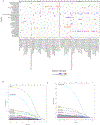Microbial glutamate metabolism predicts intravenous cocaine self-administration in diversity outbred mice
- PMID: 36592885
- PMCID: PMC9943525
- DOI: 10.1016/j.neuropharm.2022.109409
Microbial glutamate metabolism predicts intravenous cocaine self-administration in diversity outbred mice
Abstract
The gut microbiome is thought to play a critical role in the onset and development of psychiatric disorders, including depression and substance use disorder (SUD). To test the hypothesis that the microbiome affects addiction predisposing behaviors and cocaine intravenous self-administration (IVSA) and to identify specific microbes involved in the relationship, we performed 16S rRNA gene sequencing on feces from 228 diversity outbred mice. Twelve open field measures, two light-dark assay measures, one hole board and novelty place preference measure significantly differed between mice that acquired cocaine IVSA (ACQ) and those that failed to acquire IVSA (FACQ). We found that ACQ mice are more active and exploratory and display decreased fear than FACQ mice. The microbial abundances that differentiated ACQ from FACQ mice were an increased abundance of Barnesiella, Ruminococcus, and Robinsoniella and decreased Clostridium IV in ACQ mice. There was a sex-specific correlation between ACQ and microbial abundance, a reduced Lactobacillus abundance in ACQ male mice, and a decreased Blautia abundance in female ACQ mice. The abundance of Robinsoniella was correlated, and Clostridium IV inversely correlated with the number of doses of cocaine self-administered during acquisition. Functional analysis of the microbiome composition of a subset of mice suggested that gut-brain modules encoding glutamate metabolism genes are associated with the propensity to self-administer cocaine. These findings establish associations between the microbiome composition and glutamate metabolic potential and the ability to acquire cocaine IVSA thus indicating the potential translational impact of targeting the gut microbiome or microbial metabolites for treatment of SUD. This article is part of the Special Issue on "Microbiome & the Brain: Mechanisms & Maladies".
Keywords: Behavior; Cocaine; Diversity outbred; IVSA; Microbiome; Novelty; Sex differences.
Copyright © 2022 The Authors. Published by Elsevier Ltd.. All rights reserved.
Conflict of interest statement
Declaration of competing interest The authors declare that they have no known competing financial interests or personal relationships that could have appeared to influence the work reported in this paper.
Figures






Similar articles
-
Association of novelty-related behaviors and intravenous cocaine self-administration in Diversity Outbred mice.Psychopharmacology (Berl). 2015 Mar;232(6):1011-24. doi: 10.1007/s00213-014-3737-5. Epub 2014 Sep 20. Psychopharmacology (Berl). 2015. PMID: 25238945 Free PMC article.
-
The microbial community dynamics of cocaine sensitization in two behaviorally divergent strains of collaborative cross mice.Genes Brain Behav. 2023 Jun;22(3):e12845. doi: 10.1111/gbb.12845. Epub 2023 Apr 27. Genes Brain Behav. 2023. PMID: 37114320 Free PMC article.
-
Sex-dependent associations between addiction-related behaviors and the microbiome in outbred rats.EBioMedicine. 2020 May;55:102769. doi: 10.1016/j.ebiom.2020.102769. Epub 2020 May 8. EBioMedicine. 2020. PMID: 32403084 Free PMC article.
-
The Gut Microbiome and Substance Use Disorder.Front Neurosci. 2021 Aug 31;15:725500. doi: 10.3389/fnins.2021.725500. eCollection 2021. Front Neurosci. 2021. PMID: 34531718 Free PMC article. Review.
-
Understanding the Role of the Gut Microbiome and Microbial Metabolites in Non-Alcoholic Fatty Liver Disease: Current Evidence and Perspectives.Biomolecules. 2021 Dec 31;12(1):56. doi: 10.3390/biom12010056. Biomolecules. 2021. PMID: 35053205 Free PMC article. Review.
Cited by
-
Clinical and Preclinical Evidence for Gut Microbiome Mechanisms in Substance Use Disorders.Biol Psychiatry. 2024 Feb 15;95(4):329-338. doi: 10.1016/j.biopsych.2023.08.004. Epub 2023 Aug 10. Biol Psychiatry. 2024. PMID: 37573004 Free PMC article. Review.
-
Gut microbiota signatures of vulnerability to food addiction in mice and humans.Gut. 2024 Oct 7;73(11):1799-1815. doi: 10.1136/gutjnl-2023-331445. Gut. 2024. PMID: 38926079 Free PMC article.
-
The interplay between microbiota and brain-gut axis in epilepsy treatment.Front Pharmacol. 2024 Jan 26;15:1276551. doi: 10.3389/fphar.2024.1276551. eCollection 2024. Front Pharmacol. 2024. PMID: 38344171 Free PMC article. Review.
-
Gene expression genetics of the striatum of Diversity Outbred mice.Sci Data. 2023 Aug 5;10(1):522. doi: 10.1038/s41597-023-02426-2. Sci Data. 2023. PMID: 37543624 Free PMC article.
-
Dynamic human gut microbiome and immune shifts during an immersive psychosocial intervention program.Brain Behav Immun. 2025 Mar;125:428-443. doi: 10.1016/j.bbi.2024.12.027. Epub 2024 Dec 17. Brain Behav Immun. 2025. PMID: 39701328 Free PMC article.
References
-
- Abuse N.I.o.D., 2020. Common Comorbidities with Substance Use Disorders Research Report (Bethesda, MD: ). - PubMed
-
- Ahmad B, Mufti KA, Farooq S, 2001. Psychiatric comorbidity in substance abuse (opioids). J. Pakistan Med. Assoc. 51, 183–186. - PubMed
-
- American Psychiatric Association., American Psychiatric Association, DSM-5 Task Force, 2013. Diagnostic and Statistical Manual of Mental Disorders : DSM-5. American Psychiatric Association, Washington, D.C.
Publication types
MeSH terms
Substances
Grants and funding
LinkOut - more resources
Full Text Sources
Molecular Biology Databases

